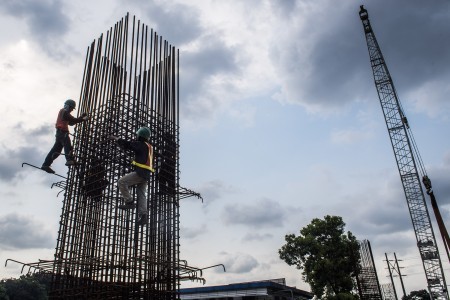Popular Reads
Top Results
Can't find what you're looking for?
View all search resultsPopular Reads
Top Results
Can't find what you're looking for?
View all search resultsIndonesia's unprecedented productivity growth
But how do we know that Indonesia’s productivity is not changing much? Economists explain GDP growth in different ways. One is to disaggregate it according to the main sources of growth, or the key inputs used in production processes: capital and labor. If GDP growth exceeds the combined growth of capital and labor, a country experiences productivity growth. This growth of total factor productivity (TFP) is a black box, and difficult to analyze further. But it is a starting point for discussion about the sources of economic growth, or the lack of it
Change text size
Gift Premium Articles
to Anyone
T
here is increasing concern about Indonesia’s slowing gross domestic product (GDP) growth during the last few years to 4.8 percent during 2015. Slowing economic growth has several consequences; most importantly it foreshadows slower growth of new employment and income opportunities. It also puts a cap on the growth of government spending, as the budget deficit is limited to a maximum 3 percent of GDP.
Several op-ed pieces in the media in recent weeks have emphasized that Indonesian producers need to improve productivity. Directly and indirectly, commentators have expressed concerns about Indonesia’s low productivity performance, noting the need for technological change in order to improve productivity and increase economic growth.
But how do we know that Indonesia’s productivity is not changing much? Economists explain GDP growth in different ways. One is to disaggregate it according to the main sources of growth, or the key inputs used in production processes: capital and labor. If GDP growth exceeds the combined growth of capital and labor, a country experiences productivity growth. This growth of total factor productivity (TFP) is a black box, and difficult to analyze further. But it is a starting point for discussion about the sources of economic growth, or the lack of it.
Echoing the work of a generation of economic historians, such as Angus Maddison, Nobel Prize winner Paul Krugman wrote in his 1994 book The Age of Diminishing Expectations: “Productivity isn't everything, but in the long run it is almost everything. A country’s ability to improve its standard of living over time depends almost entirely on its ability to raise its output per worker.”
But estimating TFP growth is not easy. While it is now possible to approximate the growth of employment, estimating the growth of capital stock in an economy is not without significant difficulties. So too in the case of Indonesia.
Indonesia’s Central Statistics Agency (BPS) has fine-tuned employment estimates since the 1970s through the Sakernas employment survey. In 1997, the BPS also made a start with estimating Indonesia’s capital stock, but it has yet to start publishing official estimates on a regular basis.
A few years ago I expanded this BPS research to estimate capital stock in Indonesia in the long run, and to use these estimates to approximate TFP growth in Indonesia during 1880-2008. It turned out that increasing capital stock explained 62 percent of GDP growth, and the mobilization of people in gainful employment combined with improvements in education a further 31 percent, leaving just 6 percent for TFP growth.
But there were phases with significant TFP growth spurts: 1933-1941, 1951-1961, 1967-1974 and 2000-2008. Each was short, and came after a period of economic crisis: the early 1930s, the mid-1940s, the mid-1960s and 1997-1998. Following each crisis, capital formation (investment) slowed and producers were required to be innovative and make the most of the people they employed and the capital they mustered. It was very different to the 1880-1929 and 1975-1997 periods when TFP growth was negative, although economic growth was positive, especially during the Suharto era.
Using recent national accounts data from the BPS to update these estimates, it now turns out that TFP growth explains an unprecedented 29 percent of GDP growth during 2000-2015. This is at a time when capital formation has been at an all-time high of 32 percent of GDP during 2010-2015. It is difficult to see it go much higher than that.
Nevertheless, the growth of capital stock is around 5-6 percent per year, no longer the 11-12 percent seen during the Suharto years. At the same time, employment growth is slowing due to decreasing population growth since the 1980s, and improvements in educational attainment remain slow but gradual. In other words, Indonesia’s economic growth may be held back by productivity growth, but productivity growth in the country has actually been at historically unprecedented levels during 2000-2015.
It may be good to look more closely at what sustained this productivity growth in Indonesia during these 15 years, rather than harp on that it is too low. For example, it is often forgotten that most of Indonesia’s economic growth is driven by the growth of domestic demand, rather than foreign demand for Indonesian products. And that most companies meeting increased domestic demand are Indonesian companies, rather than foreign firms operating in Indonesia. Indonesian firms rely on each other to produce and deliver the increasing amounts of goods and services that Indonesian end users are buying, creating new employment in the process.
Somehow, companies in Indonesia find ways to overcome the difficulties that cause Indonesia to languish in the bottom half of countries in the World Bank’s Doing Business project. How do those companies overcome credit constraints, transportation and infrastructure shortcomings, bureaucracy, etc., and what policy-relevant lessons can be drawn? Answers to such questions may foster productivity and economic growth, rather than vague calls for technological change and productivity growth.
***
Pierre van der Eng is an associate professor in international business at the Australian National University. He published the book Business in Indonesia: New Challenges, Old Problems with former finance minister M. Chatib Basri. His research on estimating TFP was published in Explorations in Economic History in 2010.
---------------
We are looking for information, opinions, and in-depth analysis from experts or scholars in a variety of fields. We choose articles based on facts or opinions about general news, as well as quality analysis and commentary about Indonesia or international events. Send your piece to community@jakpost.com.










